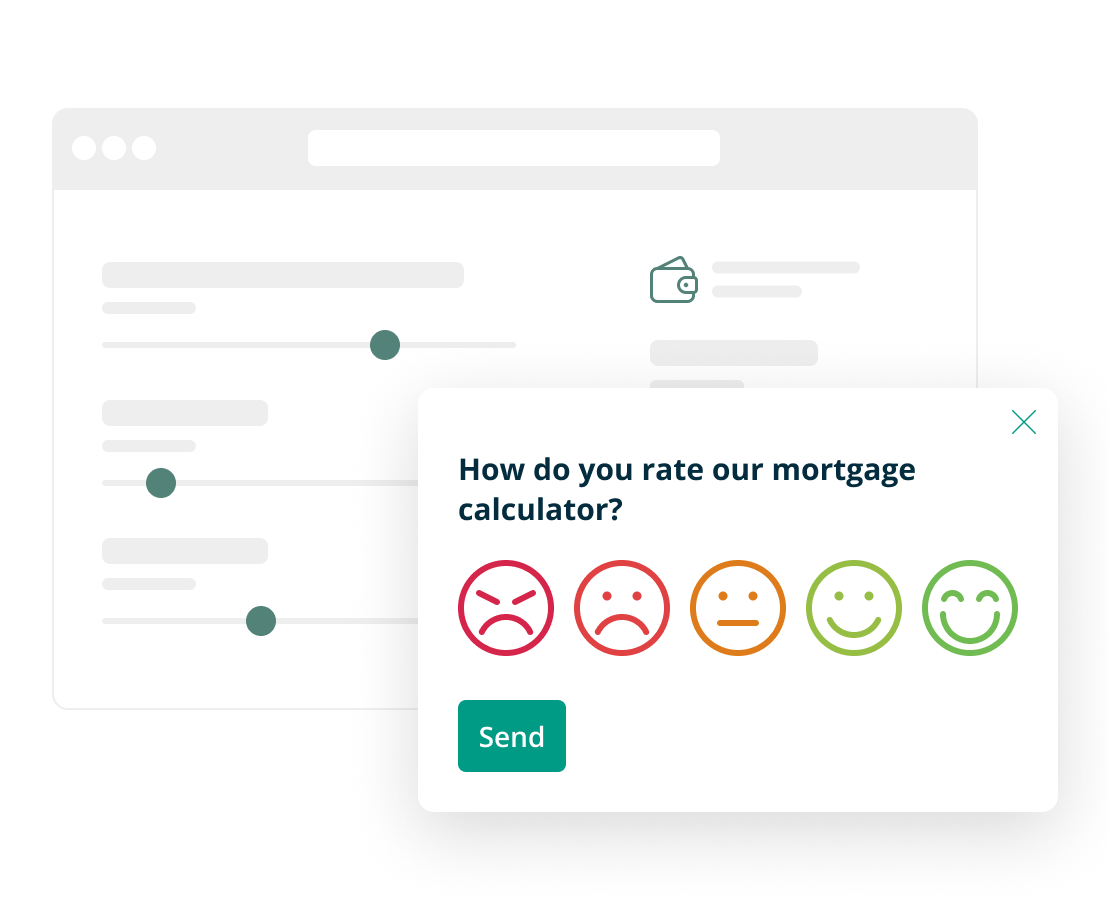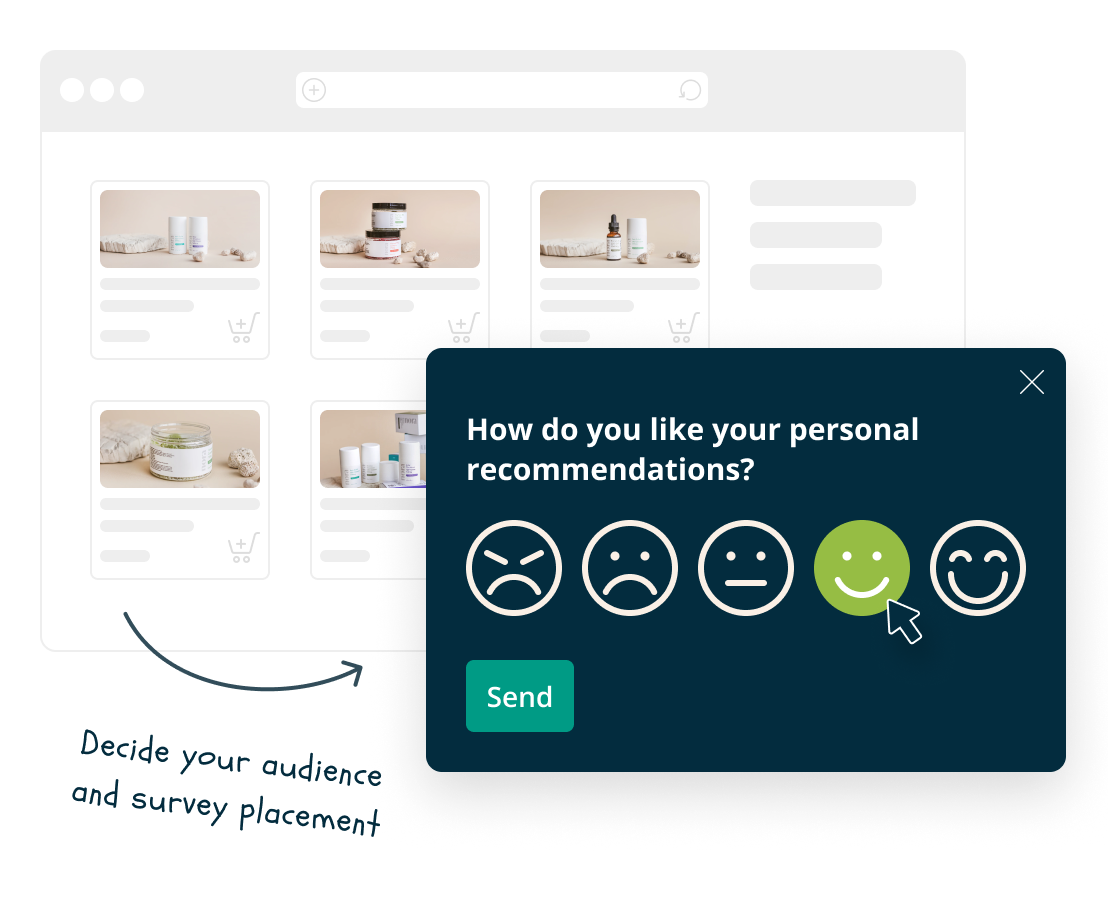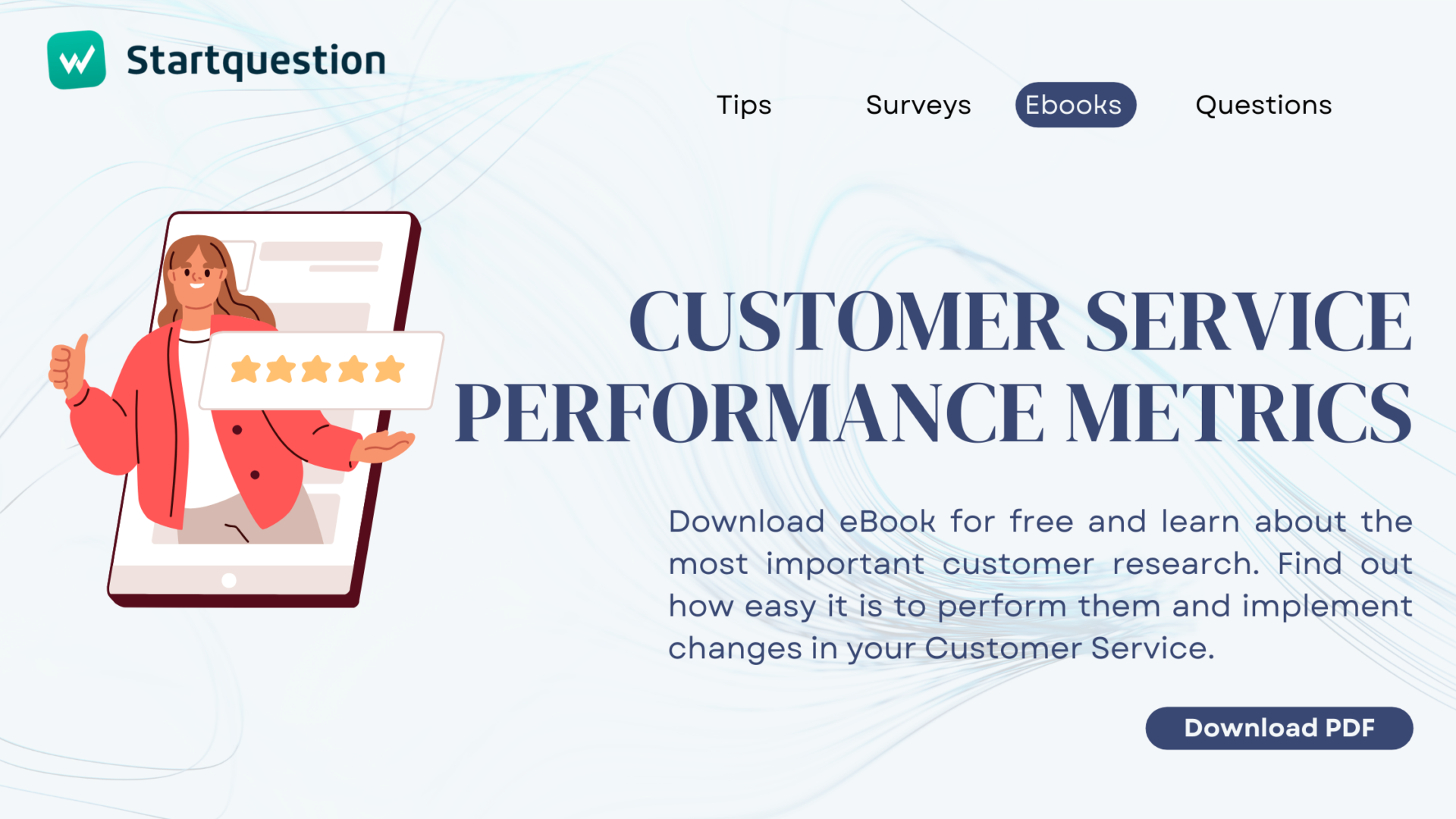Gathering feedback on your website is crucial for identifying issues, improving user experience, increasing engagement, enhancing conversion rates, and gaining insights into your target audience. By listening to your users, you can make informed decisions that drive success for your website and business.
In this article, we will provide you with insights regarding different types of website feedback, as well as the best website feedback tools and tips to understand user behavior and make your job easier.
Why Should You Gather Feedback about Your Website?
Gathering feedback data about your website is essential to improving user experience, identifying and fixing technical issues, increasing engagement, building trust, and staying ahead of the competition.
Website feedback widgets and proper survey questions can provide you with information essential to strengthen the following areas of your online activities:
Click on the picture to display survey template
Explore more ready-to-use surveys for your website!
Optimize Accessibility
Accessibility refers to the degree to which your website is designed to accommodate all users, including those with disabilities, and to provide an inclusive experience for all visitors. Collecting feedback can be precious when it comes to optimizing accessibility. Here are some ways in which direct feedback can help you maximize it:
Identify Barriers
Feedback from visitors with disabilities can help you identify any obstacles they encounter when using your website. For example, they may need help navigating your site, using specific features, or accessing content. By grabbing direct customer feedback, you can change your website to make it more accessible.
Prioritize Improvements
User insights can help you prioritize the most critical changes that need to be made to your website to improve accessibility. By focusing on the changes that will impact your users, you can make the most efficient use of your resources.
Test Solutions
Once you have identified barriers and prioritized improvements, you can test solutions with users (for instance, with feedback forms) to see if they are effective. It will help you determine if the changes you have made have improved accessibility or if you need to make additional adjustments.
Maintain Compliance
Collecting user feedback can also help you maintain compliance with accessibility standards, such as the Web Content Accessibility Guidelines (WCAG). Visitors can point out areas where your website is not meeting these standards, and you can make changes to bring your site into compliance.
Overall, feedback from website visitors with disabilities is essential for optimizing accessibility. By understanding their needs and experiences, you can make changes that improve the inclusivity and usability of your website.
Remove Conversion Barriers
Conversion barriers prevent website visitors from taking a desired action, such as purchasing or filling out a contact form. Here are some ways in which valuable customer feedback can help you remove conversion barriers:
Identify barriers
Customer feedback tools can help you identify the obstacles preventing visitors from converting. For example, they may need clarification on your checkout process or have concerns about the security of your site. By understanding these barriers, you can change your website to address them.
Prioritize improvements
Feedback analysis can help you prioritize the most critical changes needed to improve conversion rates. By focusing on the changes that will impact your users, you can make the most efficient use of your resources.
Test solutions
Once you have identified barriers and prioritized improvements, you can test and analyze user behavior to see if they are effective. It will help you determine if the changes you have made have improved conversion rates or if you need to make additional adjustments.
Increase trust
Feedback can also help you increase confidence with your visitors, which can lead to improved conversions. Visitors may have concerns about the security of their personal information or the quality of your products or services. Addressing these concerns can increase their confidence in your brand and encourage them to convert.
Overall, feedback from website visitors is essential for removing conversion barriers. By understanding their needs and experiences, you can make changes that improve the usability and trustworthiness of your website, which can ultimately lead to increased conversions.

Content Optimization
Website visitor feedback (combined with website analytics tools) can be invaluable for optimizing your website’s content. Here are some ways it can help:
Identify Areas for Improvement
Website surveys can help you identify areas of your website’s content that may need to be clarified, challenging to navigate, or simply not engaging. You can use this information to make changes to your content that will better meet the needs and expectations of your audience.
Improve User Experience
Feedback can help you understand how visitors interact with your website and where they may be experiencing issues. By making changes to your content based on this feedback, you can improve the overall user experience and make it easier for visitors to find what they want.
Enhance Engagement
By listening to feedback from your visitors, you can better understand their interests and preferences. It can help you create more engaging content that resonates with your audience and keeps them returning for more.
Increase Conversions
Optimizing your website’s content based on visitor feedback can make it more effective at driving conversions. Whether you want to increase sales, sign-ups, or some other type of conversion, feedback can help you create more persuasive and compelling content.
Overall, website visitor feedback is a valuable resource that can help you optimize your website’s content in various ways. By paying attention to what your visitors say, you can create a more engaging, user-friendly, and effective website to achieve your business goals.
Improve Customer Retention
Website visitor feedback can be an invaluable tool for improving customer retention. By listening to the feedback of your website visitors, you can gain valuable insights into what your customers are looking for, what they like about your website, and what they don’t like. Here are a few ways website visitor feedback can improve customer retention:
Address Customer Concerns
Website visitor feedback can help you identify and address any concerns or issues customers may have with your website. It can improve their overall experience and help them feel more positive about your brand, encouraging them to continue using your products or services.
Improve Website Navigation
Website visitor feedback can help you understand how easy or difficult it is for customers to navigate your website. By improving website navigation, you can make it easier for customers to find what they’re looking for, increasing their satisfaction with your brand.
Personalize the User Experience
By understanding the needs and preferences of your website visitors, you can personalize their experience. Personalization can increase customer loyalty and encourage repeat business. It can include tailoring content or offers to their interests or providing customized recommendations based on browsing history.
Increase Customer Satisfaction
Website visitor feedback can help you understand what customers like about your website and what they find valuable. By focusing on what customers enjoy, you can improve overall customer satisfaction, leading to increased retention and loyalty.
Build Trust
By listening to customer feedback and taking action on their concerns, you can build trust and demonstrate that you value their input. It can foster long-term relationships with your customers and increase their likelihood of remaining loyal to your brand.
Overall, website visitor feedback can provide valuable insights into the needs and preferences of your customers. By acting on this feedback and making changes to improve the customer experience, you can increase customer retention and build a solid and loyal customer base.
Website Feedback Survey Template
Is your website or online store user-friendly and meets all visitors’ expectations? It’s high time to find it out! Use feedback surveys to learn how to improve your online activities and attract more users.
Discover Bugs
Website visitor feedback can be an excellent source for discovering bugs in a website. There are several ways in which feedback from visitors can help uncover bugs:
Reporting Issues
Visitors may report problems they encounter while using the website. For example, they may notice a link is broken, or a page is not loading correctly. These reports help identify bugs that have gone unnoticed.
Providing Specific Details
Visitors may provide specific details about the issues they are experiencing, such as error messages or browser information. This information can help reproduce and diagnose the problem.
Identifying Patterns
If multiple visitors report similar issues, it may indicate a more significant problem that needs to be addressed. For example, if several visitors say that a particular form is not submitted correctly, it may mean a bug in the form’s code.
Suggesting Improvements
Visitors may suggest improvements to the website that could help prevent future bugs. For example, they may suggest adding more descriptive error messages or improving the website’s performance.
To leverage visitor feedback to uncover bugs, it’s essential to have a system in place for collecting and tracking feedback. It could include a feedback form on the website, an email address for visitors to send feedback to, or a dedicated feedback platform.
Once feedback is collected, it should be reviewed and prioritized based on the severity and frequency of the reported issues.
Surveys are an effective way to collect website feedback. They provide direct input from users and can help website owners identify areas for improvement and make data-driven decisions to boost user experience.
Ways to Collect Website Feedback
Collecting website feedback is essential for improving user experience and increasing user engagement. Here are some of the best ways to collect website feedback:
Feedback Surveys (With Examples)
Surveys are an effective way to collect website feedback. They provide direct input from users and can help website owners identify areas for improvement and make data-driven decisions to boost user experience.
Website Feedback Survey Values:
- Understanding user experience: Surveys can help website owners understand how users experience their website. By asking questions about ease of use, navigation, design, and functionality, website owners can identify areas for improvement and address user pain points.
- Identifying user preferences: Surveys can help website owners learn about user preferences for content, features, and functionality. By gathering this information, website owners can tailor their websites to meet the needs and preferences of their users.
- Measuring user satisfaction: Surveys can help website owners measure user satisfaction with their website. By asking users to rate their experience and provide feedback, website owners can identify areas where they excel and areas where they need to improve.
- Collecting suggestions for improvement: Surveys can help website owners collect hints directly from their users. By asking open-ended questions, website owners can gather feedback on specific aspects of their website and use it to improve.
Website Feedback Survey Questions Examples
- Is there anything missing on this page?
- What is the primary reason for choosing us over competitors?
- What is the most important feature of our product?
- How can we improve our website?
- What is your preferred payment/delivery method?
- Is our pricing clear to you?
Get inspired by our ready-to-use customer feedback forms and other survey templates examples to listen to the voice of the customer or user of your website.

Widgets and Buttons
Website feedback widget and buttons can be an effective way to collect user insights. Here are a few ways in which widgets and buttons can help:
Increase Visibility
Widgets and buttons can increase the visibility of feedback options on a website. By placing feedback options in prominent locations, such as the top or bottom of a page, users are likely to notice and engage with them.
Provide Quick and Easy Access
This solution can provide quick and easy access to feedback options. Website users can simply click a button or widget to access a feedback form without navigating to a separate page.
Offer Multiple Feedback Options
Widgets and buttons can offer users numerous feedback options, such as a rating system, comment box, or survey. It allows users to provide feedback in various formats, depending on their preferences.
Allow for Targeted Feedback
Buttons or widgets can be targeted to specific pages or sections of a website. For example, a button could be placed on a product page to gather feedback specifically about that product.
Provide In the Moment Feedback
Widgets and buttons can provide real-time feedback to users. For example, a widget could display the average rating of a product based on user feedback, providing users with immediate feedback and social proof.
Widget and feedback buttons can be valuable tools for collecting website feedback. Website owners and developers should consider using widgets and buttons to increase the visibility and accessibility of feedback options, offer multiple feedback options, and provide real-time feedback to users.
Website Feedback Popup
A website feedback button or popup is a small window that appears on a website and asks users to provide feedback. Here are a few ways in which website feedback popups can help collect website feedback:
Prompt Users to Provide Feedback
Website feedback popups can prompt users to provide input while actively engaging with the website. This can increase the likelihood that users will provide feedback, as they are already focused on the website and its content.
Provide a Direct Channel for Feedback
Popups provide a direct channel for users to provide feedback. Users can quickly and easily offer their thoughts and suggestions without navigating to a separate feedback page.
Allow for Targeted Feedback
Website feedback popups can be targeted to specific users or pages on the website. For example, a feedback popup could be triggered after a user has spent a certain amount of time on a page or after completing a specific action on the site.
Website feedback can help identify usability issues, such as confusing navigation or poor layout design. Users may also point out technical issues like broken links or slow page loading speeds.
Encourage User Engagement
Feedback popups can encourage user engagement and demonstrate that the website values user feedback. Users are more likely to continue engaging with the website when their feedback is being heard and acted upon.
Collect Quantitative Data:
Website feedback popups can be used to collect quantitative data, such as user ratings or satisfaction scores. This data can be used to track changes in user satisfaction over time and identify areas for improvement.
Overall, popups can be valuable for collecting website feedback. Website owners and developers should consider using feedback popups to prompt users to provide feedback, target specific areas of the website, and demonstrate their commitment to user satisfaction.
User Reviews
User reviews can be a valuable source of feedback for website owners and developers. It is worth emphasizing that this is particularly important in local SEO (the more good opinions, the better position in Google Maps).
Here are a few ways in which user reviews can help collect insights:
Identify Usability Issues
Online comments can help identify usability issues on a website, such as confusing navigation or poor layout design. Users may also point out technical issues like broken links or slow page loading speeds.
Highlight Areas for Improvement
User reviews can provide valuable insights into what users like and dislike about a website. This feedback can be used to improve the site, such as by adding new features or changing the design.
Build Trust
Online reviews can help build trust with potential customers. When people see positive reviews from other users, they are more likely to trust the website and feel comfortable making a purchase or engaging with it differently.
Gauge Customer Satisfaction
User voices can be used to gauge customer satisfaction and identify areas where the website is falling short. This information can be used to improve the customer experience and increase user engagement.
Encourage User Engagement
User reviews can encourage users to engage with the website and provide feedback. When users see that their feedback is valued and acted upon, they are likely to continue recommending the site to others.
Collect authentic customer reviews to improve the user experience. Website owners and developers should pay attention to user feedback and use it to improve their sites.

The Power of Social Media…
Social media is an excellent platform for connecting with users and getting feedback. You can use social media channels like Twitter, Facebook, and Instagram as community feedback tools to gather qualitative data from your followers.
… And Old-Schooled Email
You can also use email to collect feedback from your users. You can send out a feedback survey or ask users to reply to your email with their feedback.
By using any of the above-mentioned methods, you can gather valuable website customer feedback from your users and make improvements.
Website Feedback Software. Alternatives to Choose From
There are many great software tools available for collecting website feedback. Here are some popular options:
Hotjar
Hotjar is a user feedback and behavior and web analytics tool that offers website feedback through surveys, polls, and heat maps. It also provides user recordings and funnel analysis.
Qualaroo
Qualaroo allows you to collect user feedback through surveys and polls that can be customized based on user behavior. It also offers sentiment analysis to help you understand the emotions behind user feedback.
UserTesting
UserTesting allows you to collect website feedback through user testing, where participants are asked to complete specific tasks on your website and provide feedback on their experience.
Google Forms
Google Forms is a free tool that can be used to collect feedback through surveys and polls. It offers a range of question types and customization options, as well as integration with other Google tools.
Startquestion
Startquestion is a popular survey tool that can be used to collect website feedback. It offers a range of question types and customization options, as well as reporting and analysis features.
Ultimately, the best software tool for collecting feedback will depend on your specific needs and budget. Try out a few options to see which website feedback management tool works best for you.

Website Feedback Tools – Sum up
Any type of direct feedback tool allows website owners to gather valuable user and visitor feedback. This feedback can provide insight into the user experience, needs, and areas where improvements can be made.
Here are some key benefits of using website feedback software:
Improving User Experience
Website feedback software can help identify areas where users are struggling or where improvements can be made to enhance the user experience. This information can be used to make changes to the website to better meet users’ needs.
Identifying Bugs and Technical Issues
Feedback software can help identify technical problems or bugs that may impact the user experience. This information can be used to address these issues quickly and improve the overall performance of the website.
Understanding User Behavior
Feedback tools can provide insights into how users interact with the website, including which pages they visit most frequently and which features they use most often. This information can be used to optimize the website to better meet users’ needs.
Increasing Customer Satisfaction
By soliciting and addressing user feedback, website owners can demonstrate that they are committed to providing a positive user experience. This can increase and measure customer satisfaction and loyalty.
Gathering Customer Insights
Feedback software can provide valuable insights into users’ needs, preferences, and opinions. This information can be used to inform product development, marketing strategies, and other business decisions.
Finally, with survey tools, you can improve the user experience, address technical issues, and gather valuable insights into user needs and preferences.
Ready to create surveys and collect data with our feedback website tool?








